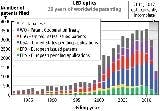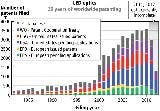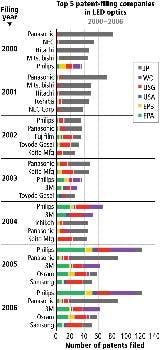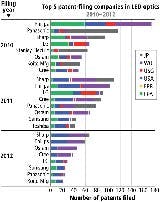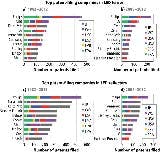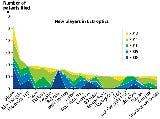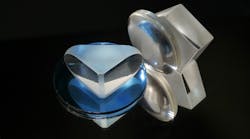This article was published in the April 2013 issue of LEDs Magazine.
View the Table of Contents and download the PDF file of the complete April 2013 issue, or view the E-zine version in your browser.
+++++
Solid-state lighting (SSL) products are very much a complex system with innovation occurring in the packaged LEDs, but also in other areas such as optics, drivers, thermal management, and more. Indeed, optics developments have been critical. If you would have followed the patent activity in the optics area over the past 20 years, or even just the last six, you may have been able to predict the companies that would find success manufacturing LED-based lighting products. A similar examination might foretell who the major players will be down the road.
Of course, the burgeoning interest in LEDs has not been limited to bulbs for residential and commercial lighting. These days, LEDs are everywhere — in traffic signals, illuminating wine cellars, draped across San Francisco’s Bay Bridge (www.ledsmagazine.com/news/10/3/6), shaped into colorful, holiday-themed animals at zoos across the United States — and their role in future lighting applications seems very bright.
Disruptive innovation
What caused the LED revolution and how did the winners in SSL succeed? Conventional wisdom attributes chip-level innovations from Shuji Nakamura of Nichia and Alberto Barbieri of Cardiff University in the early to mid-1990s as the fundamental basis for commercially-viable, high-brightness LEDs. Because the light output of LED bulbs ultimately relies on system-wide synergies, however, it is easy to question the true impact of these developments. Even the brightest p-doped GaN-on-sapphire substrate cannot illuminate a living room on its own. Nevertheless, the patent record seems to indicate that these pioneering innovations — possibly in combination with others from the same era — likely served as a driving force for the development of other cutting-edge technologies in the LED lighting space.
Although many other components are equally vital to high-powered LED bulbs, primary and secondary optics are largely responsible for the quality and character of the light that reaches the consumer’s eye. In order to maximize luminous efficacy, bulb manufacturers must ensure that primary and secondary optics are compatible with a given chip and that the entire system is suitable for its intended purpose. Therefore, to capitalize on the dramatic increases in efficiency and light output offered by GaN p-doping (and other chip-level technologies), bulb manufacturers needed to find (or develop) suitable light-enhancing components.
Optics patent velocity
These days, “disruptive innovation” is almost a cliché. Looking at LED optics patenting, however, it is hard to dispute the disruptive effect of Nakamura’s and Barbieri’s advancements. Between 1995 and 2000, nearly half of all patents relating to LED optics were filed in Japan. By 2002, this fraction had dwindled to approximately 20% of the total, and the overall number of Japanese patent filings had also declined, from 879 in 2001 to 487 in 2004.
In 2010, the last year for which we have complete filing data available, 50% of all LED optics patent filings occurred in the US with the remainder relatively evenly divided between the European, Japanese, and PCT (Patent Cooperation Treaty) (WO) patent offices. Because companies file patents to protect their products in certain regions, the changing geographic focus of LED optics patent filings demonstrates the dramatic shift in the market for LED optics technologies, contemporary to that time period.
Regional markets for LED optics technologies were not the only thing to shift in the early 2000s, however, as the companies that dominated innovation in this space also changed. In 2000, the four of the top five patent-filing companies in LED optics were Japanese, and these companies filed patents almost exclusively in Japan (Fig. 2). By 2006, three of the five top-filing companies were either American or European, and — with the exception of Panasonic, which still filed primarily in Japan — almost all of the patenting activity of the five top-filing companies was directed towards the US and European markets.
Movers and shakers
That the patent record can track historical events is interesting, but what use does it have for us today? To answer, recall that, as late as 2007, common wisdom held that LED lighting was still a futuristic daydream — perhaps not as distant as jet packs and rocket cars, but certainly not something that would soon be appealing to the average, cost-conscious consumer. Yet the patent record indicated something different. Large lighting companies were investing heavily in optics, as though developing a diverse array of LED bulb components might have some near-term market value.
New consumer items do not magically appear overnight. Developing a lab-bench prototype into an off-the-shelf product can take years, but forward-thinking companies rush to protect their prototypes, often well before such experiments turn into anything resembling a marketable product. This is why the patent record can predict where a company (or an industry) thinks the future is heading. These predictions can give us a sense of what ideas are in the pipeline, often years before they come to fruition or hit the shelf.
That said, let’s take a look at patenting in today’s LED optics market. Fig. 3 shows the eight top-filing companies in 2010, 2011, and 2012. The space appears to be dominated by lighting and display manufacturers. Realize, however, that given the diversification of many large companies, it is difficult to conclusively establish the intended applications of disclosed technologies without reading the individual patents. Perhaps unsurprisingly, Cree filed nearly twice as many LED optics patents in 2011 than it did in 2010. This flurry of innovative activity may be interpreted as a predictive indicator of the company’s recently released LED lamps that are under $10 for 40W-incandescent-equivalent light output.
It is difficult to find a place in LED optics patenting that is not overwhelmingly dominated by Philips. In the last five years, Philips has filed more collimator-related patents (181) than its closest competitor, Panasonic, which has filed 146 of these patents since 1982. The numbers are similar, albeit less dramatic, in other optics-related areas (Fig. 5). Since 2008, Philips has filed 58 patents related to parabolic optics, 25 patents related to Fresnel lenses and reflectors, and 127 patents related to total internal reflection (TIR). Its closest competitor in each of these areas, in terms of patenting activity, has filed 72, 48, and 168 patents, respectively, but in the last 30 years. There is certainly overlap between some of these categories, and some of the patents describe inventions that are only tangentially related to the nominal technology — e.g., an LED bulb that uses a Fresnel lens — but Philips’ position in the space is clear.
Spotlight on upstarts
In addition to tracking (and predicting) market trends and defining leaders in particular technology and/or market areas, patent data can also tell us about new entrants into a space, often well before these entrants gain broad recognition. This information can be particularly valuable for larger companies that may be looking for potential acquisition targets, but it is equally useful for anyone who wants to stay up to date on emerging players in the highly dynamic LED lighting industry.
Twenty companies that meet the criteria for new entrants in LED optics each filed at least 10 patent applications, worldwide, between 2008 and 2012 (Fig. 6). Eight of these companies — Xicato, Nittoh Kogaku, PhotonStar LED, Soraa, Evolucia, Excelitas, Reflexite, and Robe Lighting — filed at least 15 patent applications during this time period. The top-filing new entrant, Xicato, filed 55.
Evolucia, once called Sunovia and branded primarily as a renewable energy provider, changed its name last year to better reflect its core business, which primarily encompasses intelligent lighting solutions. Out of Evolucia’s entire portfolio, only three patents (approximately 10% of the total) are related to solar energy conversion. The name change was reasonably foreseeable and makes perfect sense.
Nittoh Kogaku, a camera manufacturer established out of Toeisha in 1943, recently extended its lens manufacturing capabilities to SRC optics for LED illumination panels. Those who missed Nittoh’s exhibition at Kogen 2008 could have learned about this development from the patent record.
Other notables
Due to space considerations, we cannot include a full list of new LED optics players in this article. The full details are available in IP Checkups’ LED PatentEdge tool. However, there are certainly companies other than those listed above who merit recognition.
Other operations that IP Checkups finds interesting include NthDegree Technologies, a research and manufacturing company that has recently created a variety of intriguing optical solutions to complement its printed LEDs, and the team of Korean scientists from Korea Advanced Institute of Science and Technology, Firefly Institute, Korea Basic Science Institute, and Korea Research Institute of Standards and Science, that reproduced nanopatterning on firefly lanterns to produce anti-reflective LED lenses with exceptional light-extraction potential.
All of the data used to generate this article came from IP Checkups’ LED PatentEdge, a competitive intelligence and technology research tool specifically designed for the LED industry. In LED PatentEdge, patents related to LED technologies and market areas are pre-sorted into over sixty categories (LED lenses, LED drivers, etc.), enabling users to quickly gain insight into the whos, whats, and whens of LED innovation. Licensed access to LED PatentEdge is available to the public via www.ledpatentedge.com.
